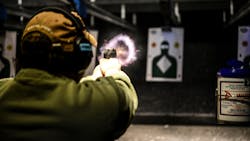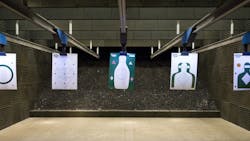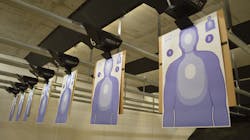Small Design Changes Lead To Big Effects On The Range
In today’s world of firearms training for law enforcement professionals, you’d be hard pressed to find a veteran instructor who believes that 100 percent of the requisite firearms training can be performed on “the square range”, a standard outdoor range with a stationary paper or steel target. That type of range has been used seemingly forever and is best suited for two things: basic marksmanship training and performing administrative qualifications. These are what you do when you shoot a course of fire that involves minimal movement, little to no verbalization of commands, no malfunction drills, limited reloads and no moving targets. It’s the course of fire you shoot to meet some arbitrary requirement usually set by a bureaucratic entity comprised of people who have never worked behind a gun.
Even for such a limited use range, there are a series of requirements that can maximize the value and, even more importantly, the safety. Some of the requirements are designed in and some are the result of proper control and management protocols. Let’s first take a look at the physical/equipment design features and then we can discuss control and management protocols. The trick is in making sure your design features empower maximum control and management protocols.
The trick is in making sure your design features empower maximum control and management protocols.
Starting with the most basic needs, the range needs to have a minimum engagement distance of 50 yards for handguns and 300 yards for rifles. While both of those distances may seem exorbitant, they can be easily justified.
Fifty yards for a pistol range allows qualification distances from one yard to fifty yards and it also allows for move-and-shoot programs that start at the 50-yard line and move a shooter up as well as across (or back and forth) on the range to closer distances. Such courses of fire are excellent for challenging your more skilled shooters and create opportunity for competition between them, pushing them to shoot to their limits in time against marksmanship.
As for rifles, with many agencies carrying a weapon equipped with a 16”+ barrel and chambered for .223/5.56mm, accuracy and skill should be trained / tested close to the effective range of the weapon. As an example, the Marine Corps trains out to 500 meters—roughly 547 yards—or almost double what is suggested here. Additionally, if your rifle range allows for standard patrol rifle qualification distances, it will support reasonable training for precision rifles as well. For both pistol and rifle ranges, obviously the berm has to be of sufficient height to support shooting from odd positions, such as laying on your back three yards from the target with a handgun, and ensuring the bullets will be stopped. Even if your design is such that you feel it guarantees bullets will be stopped, the area behind your ranges needs to be clear and kept vacant for at least a mile and sometimes more depending on what you’ll typically be shooting (for outdoor ranges).
Lighting on your range has to be adjustable whether indoor or outdoor. Indoor this is relatively easy because dimmer switches and programmable light levels are easy to manage. Outdoor requires you to install artificial lights that are still adjustable but have a maximum light level that makes the shooting lines as easy to see at midnight as they are during the brightest part of the afternoon.
Challenge your range
Now let’s take a look at a few small things you can do to add some functionality and challenge to your range, with a reasonably low cost. Moving targets—whether it is forward and backward in relation to the shooter or perpendicular to their shooting position—add a higher level of challenge and more accurately simulate real world shooting situations. If your agency has the dollars to spend, using moving targets that are programmable and on all lanes of fire are fantastic. If you’re from an agency with a smaller budget, however, and you can run shooters through programs one at a time, a simple rolling platform, some rope and a few pulleys can empower moving target training.
Shooting from cover is something all officers should learn to do but many ranges have either a folding wall piece or a 2x8 stuck in the ground for a barricade. Get creative. Up the training level by using other items for cover such as 55-gallon barrels, old U.S. Post Office mailbox (the big kind usually found at community entrances), picnic tables as obstacles and more.
Create a move and shoot course that takes the shooter from one side of your range to the other as they move forward and then back from point of cover to point of cover while engaging the target(s) from each position. Focus on ensuring reloads while behind cover and making sure the shooter keeps their finger off the trigger between positions of cover, as well as keeping the weapon oriented down range.
If you don’t have any reactionary/steel targets on your range, see about acquiring “a rack.” Six to 12 8-inch steel plates that are resettable with a rope pull can make firearms training more fun, more entertaining, more competitive, and a greater learning experience. They can help teach shooting rhythm, faster sight acquisition, and more.
Finally, if you can’t spend any money at all, have a very basic square range and want to enliven the training for cheap, go out and find more entertaining targets. With everything available on today’s market from zombie clowns to hostage targets to neutral targets that come with high-threat / no-threat decals so you can design your own, new targets can surprise your shooters and bring something new to a stale qualification course.
REMINDER: Firearm maintenance is a must
After the shooting day is done, your officers shouldn’t be allowed to leave the range until after they’ve cleaned their weapons. That means you should have either an outdoor cleaning station or a very well ventilated indoor one. All the requisite cleaning supplies, brushes, swabs, etc. should be part of your range equipment consumables budget line. Remember that all that carbon and lead is considered a biohazard and review health safety where lead poisoning is concerned with your shooters.
About the Author
Lt. Frank Borelli (ret), Editorial Director
Editorial Director
Lt. Frank Borelli is the Editorial Director for the Officer Media Group. Frank brings 20+ years of writing and editing experience in addition to 40 years of law enforcement operations, administration and training experience to the team.
Frank has had numerous books published which are available on Amazon.com, BarnesAndNoble.com, and other major retail outlets.
If you have any comments or questions, you can contact him via email at [email protected].



